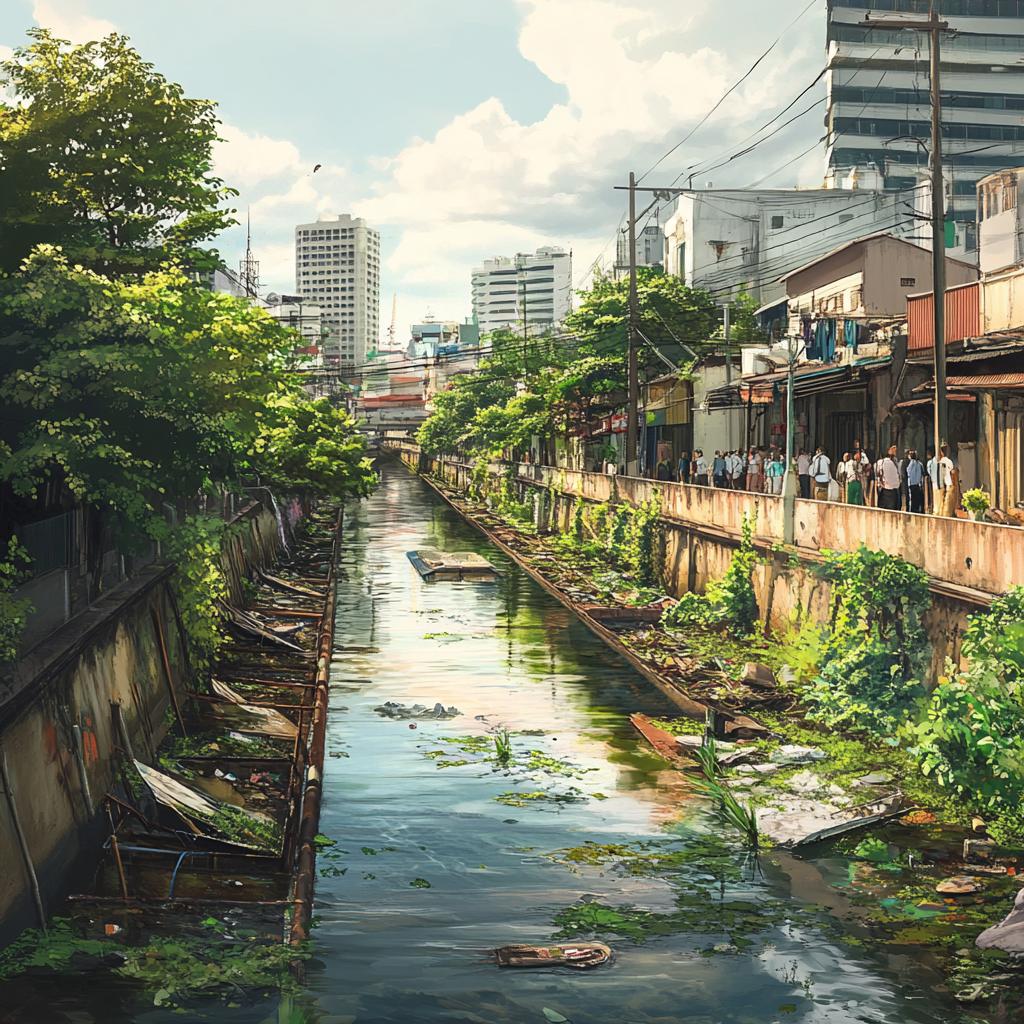Amidst the hustle and bustle of Bangkok’s vibrant cityscape, the persistent issue of pollution plaguing its canals has become a priority for city officials. Mr. Jetsada Jantraprapa, the astute Director-General of the Drainage and Sewerage Department (BMA), has rolled out an elaborate plan to tackle this old adversary with a mix of traditional methods and modern technology.
Picture this: four ingenious debris traps strategically positioned at Trok Sake, Dinso Road, Maha Chai Road, and the Khlong Ong Ang discharge point. Like steadfast sentinels, these traps are cleared twice a day—morning and afternoon—amassing a staggering 600-700 kilograms of detritus from the city’s lifeblood. Most of this stems from the bustling Trok Sake area, a hub of food distribution for the less fortunate, and sadly, an inadvertent dumping ground for local residents. But clearing trash alone isn’t enough to stem the tide of pollution.
Enter a more robust tactic. Rallying support from the Phra Nakhon District Office, the department is rolling out a campaign that is as formidable as it is necessary. Increased surveillance via city inspectors, coupled with impassioned public appeals against the insidious practice of dumping, aims to shift the culture of waste disposal. Trok Sake, in particular, is in the crosshairs for new regulations around food distribution, aimed at reducing collateral pollution.
The plot thickens as the department strategizes with partners like the Phra Nakhon District and the Traffic and Transportation Department. Plans are brewing to deploy CCTV cameras—not just as an eye in the sky but as a technological watchdog ready to pounce with legal repercussions on offenders caught in the act.
Yet, this saga of cleanliness is not just a surface-level skirmish. February 2025 marked the completion of dredging operations designed to unearth and remove the hidden burdens of underwater debris and sediment—the silent saboteurs of water quality. But this isn’t just about clearing what was. It’s about building for what will be.
The pièce de résistance in this strategic orchestration is a new wastewater collection system. A network of 315-millimetre HDPE secondary pipes is weaving its way along Khlong Lot Wat Ratchanadda and Khlong Lot Wat Ratchabophit, channeling household wastewater directly to the Rattanakosin Water Quality Control Plant. With Khlong Lot Wat Ratchabophit completed and Khlong Lot Wat Ratchanadda a whisker away from finalization by March 31st, 2025, this infrastructural marvel promises a significant uplift in the canal’s decorum.
Behind the beauty of the old city moat from which Khlong Lot Wat Ratchanadda springs, lies a determined effort to preserve its 1,160-metre stretch from the ravages of pollution. This network of canals—living veins within Bangkok’s urban body—receives relentless care. Inner-city waterways, with their heightened vulnerability to waste, undergo daily cleanings—up to thrice in particularly problematic patches—while their outlying cousins receive tailored, rotational attention.
Through these sweeping efforts, Mr. Jetsada and his team at the Drainage and Sewerage Department are not merely fighting pollution; they are crafting a legacy, one where the waterways of Bangkok run cleaner, safeguarding a city’s heritage and, perhaps, its very soul.


















This initiative sounds promising, but isn’t it too little too late? Bangkok’s canals have been suffering for decades.
It’s never too late to start making improvements, Anna. At least they’re doing something now.
I get that, but shouldn’t they have started using modern tech years ago?
Better late than never! These measures might inspire other cities to follow suit.
Absolutely, especially since urban waterways everywhere are under threat!
Why should anyone care about some stinky old canals when there are more pressing global issues?
Local issues are global issues, JoJo! Cleaner water benefits the environment and economy.
I still think there are bigger fish to fry, but if it’s so important, why did it take them so long?
I applaud Jetsada’s leadership, but I’m skeptical of how long these measures will last.
Skepticism is healthy, David, but let’s give them the benefit of the doubt. There’s always room to tweak the strategy.
It’s great to see technology like CCTV being used to curb pollution. I hope it makes a real difference.
Interesting that they’re targeting food distribution spots. I never realized how much waste they produce.
Those debris traps are such a wonderful idea! Clean canals might lead to increased tourism too.
Totally! But they need consistent maintenance, otherwise, that gunk will pile back up.
Cleaner canals would definitely make my visit to Bangkok more pleasant.
I’m curious about how they’re managing public cooperation on this initiative.
They need to educate people better about how pollution affects their daily lives. More awareness could improve compliance.
Seriously, why didn’t they deploy those wastewater pipes sooner? Infrastructure updates should be proactive, not reactive.
Agreed. The longer they wait, the more expensive and extensive the repairs.
I’m thrilled to hear about the dredging operations. Clean canals protect so many aquatic species.
These efforts are admirable, but do they have enough funding to sustain them long-term?
I hope Jetsada involves the local communities more in these plans.
How do CCTV cameras catch illegal dumping effectively? Technology alone isn’t enough.
Preserving the canals’ heritage is important, but isn’t the pollution ruining its past?
I can’t wait to see clean canals on my next trip to Bangkok. It’s part of the city’s charm!
Why not incentivize local businesses to reduce waste instead of just imposing regulations?
Do they have any plans for public recognition or rewards for neighborhoods that keep their canals clean?
That’s an excellent idea, incentives can work wonders for community engagement!